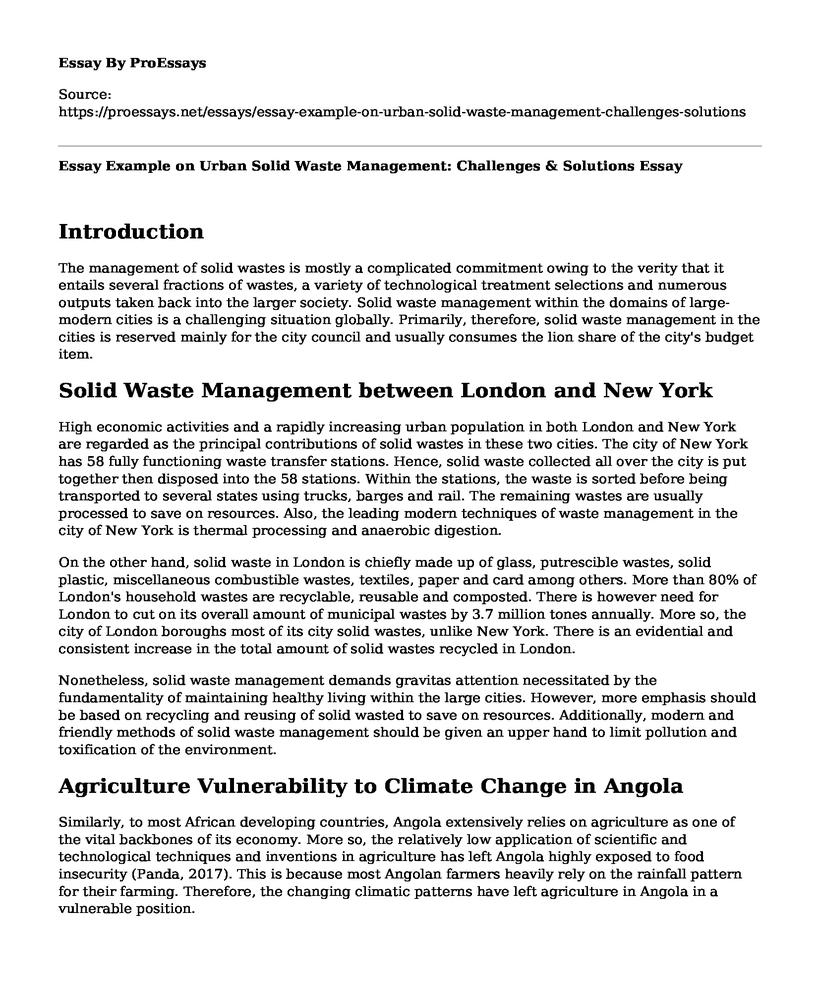Introduction
The management of solid wastes is mostly a complicated commitment owing to the verity that it entails several fractions of wastes, a variety of technological treatment selections and numerous outputs taken back into the larger society. Solid waste management within the domains of large-modern cities is a challenging situation globally. Primarily, therefore, solid waste management in the cities is reserved mainly for the city council and usually consumes the lion share of the city's budget item.
Solid Waste Management between London and New York
High economic activities and a rapidly increasing urban population in both London and New York are regarded as the principal contributions of solid wastes in these two cities. The city of New York has 58 fully functioning waste transfer stations. Hence, solid waste collected all over the city is put together then disposed into the 58 stations. Within the stations, the waste is sorted before being transported to several states using trucks, barges and rail. The remaining wastes are usually processed to save on resources. Also, the leading modern techniques of waste management in the city of New York is thermal processing and anaerobic digestion.
On the other hand, solid waste in London is chiefly made up of glass, putrescible wastes, solid plastic, miscellaneous combustible wastes, textiles, paper and card among others. More than 80% of London's household wastes are recyclable, reusable and composted. There is however need for London to cut on its overall amount of municipal wastes by 3.7 million tones annually. More so, the city of London boroughs most of its city solid wastes, unlike New York. There is an evidential and consistent increase in the total amount of solid wastes recycled in London.
Nonetheless, solid waste management demands gravitas attention necessitated by the fundamentality of maintaining healthy living within the large cities. However, more emphasis should be based on recycling and reusing of solid wasted to save on resources. Additionally, modern and friendly methods of solid waste management should be given an upper hand to limit pollution and toxification of the environment.
Agriculture Vulnerability to Climate Change in Angola
Similarly, to most African developing countries, Angola extensively relies on agriculture as one of the vital backbones of its economy. More so, the relatively low application of scientific and technological techniques and inventions in agriculture has left Angola highly exposed to food insecurity (Panda, 2017). This is because most Angolan farmers heavily rely on the rainfall pattern for their farming. Therefore, the changing climatic patterns have left agriculture in Angola in a vulnerable position.
Several climatic changes have marked themselves as dire repercussions to the practice of agriculture in Angola. Some of these climatic changes include poor as well as erratic seasonal rainfall, early cessation of rain, mid-season dry spells and devastating cyclones (Meyer, 2017). The consequences of these adverse weather fallouts scenarios are decreased agriculture in terms of inadequate crop production, livestock death and food insecurity.
Additionally, in the period 2018, beginning from October to March 2019, southern Angola experienced a severe drought that was driven by the El Nino. As a result, Southern Angola received its lowest seasonal rainfall since the year 1981 (Food and Agriculture Organization of the United Nations, 2019, p. 34). The effects of the dry spell could not be hidden, and the most affected areas were the livestock economy and agriculture. The aftermath of the draught was primarily reduced pasture, crop failure and low water availability all because of climate change.
Unfortunately, the situation is always far-reaching since its effects are felt in other segments of the economy. For instance, poor climatic condition result in increasing of fuel prices, poor accessibility to food as well as other essential human commodities (Meyer, 2017).
References
Food and Agriculture Organization of the United Nations. (2019). Meeting the climate change mitigation commitments of Least Developed Countries: The role of the agricultural sectors and the need for urgent action. Food & Agriculture, Org.
Meyer, C. (2017). Transboundary aquifer vulnerability to climate change (2014). doi:10.29104/wins.l.0011.2018
Panda, A. (2017). Climate change, drought and vulnerability. Climate Change, Vulnerability and Migration, 193-211. doi:10.4324/9781315147741-10
Cite this page
Essay Example on Urban Solid Waste Management: Challenges & Solutions. (2023, Feb 11). Retrieved from https://proessays.net/essays/essay-example-on-urban-solid-waste-management-challenges-solutions
If you are the original author of this essay and no longer wish to have it published on the ProEssays website, please click below to request its removal:
- Annotated Bibliography on Economics and Politics
- Police Officer PTSD and Mental Health Videos Reflection Essay
- Life for Women in the Ancient and Early Modern World Essay
- Paper Example on Chinese Immigration to US: Migration, Emigration, and Immigration
- Essay Example on Tourism: Impact of Solid Wastes on the Environment
- Analysis of Waste Mgmt: 6 Pillars & Moral Philosophies - Essay Sample
- Youth Homelessness - Research Paper Sample







